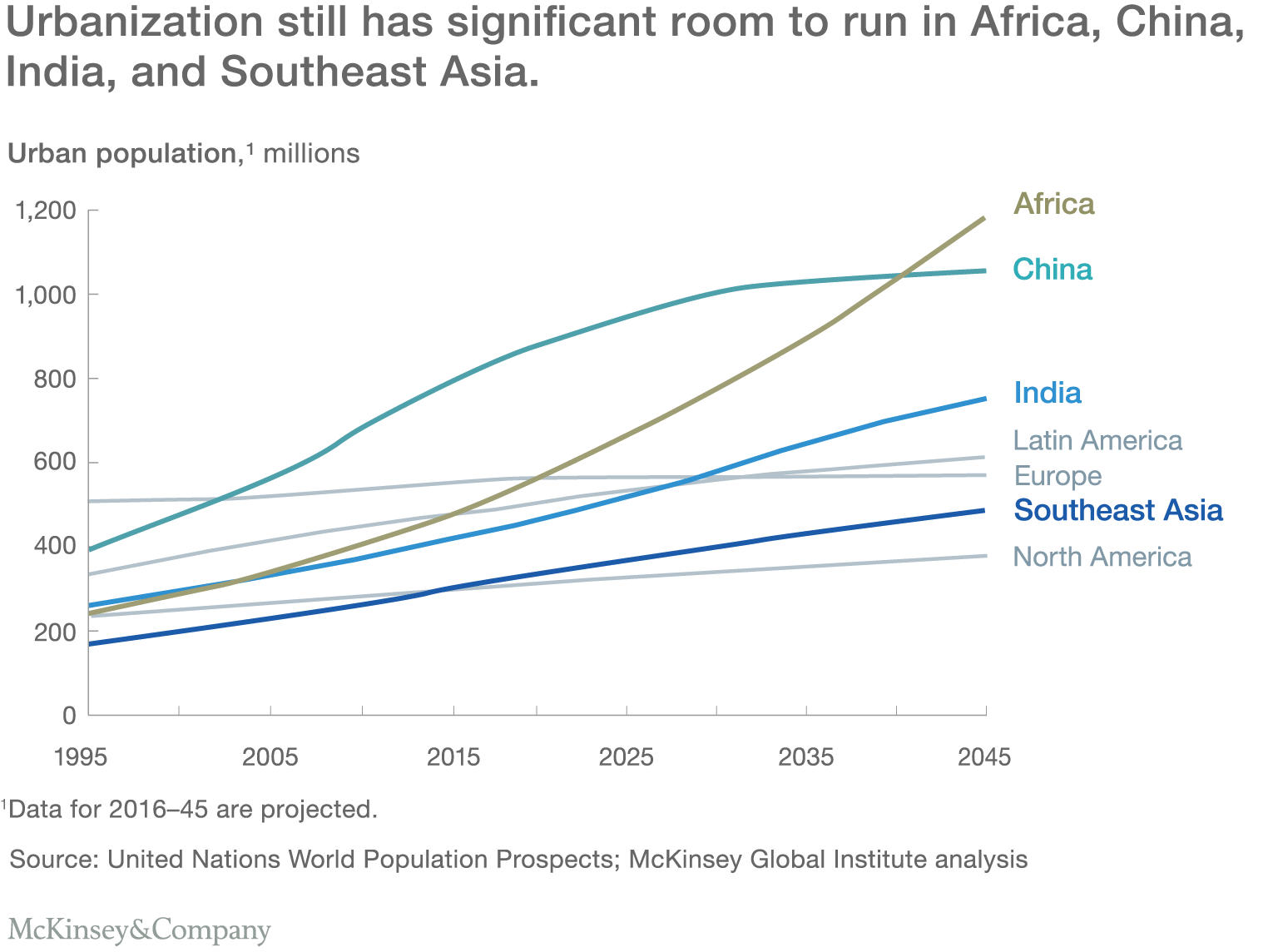My colleagues Martin Hirt and Chris Bradley recently blogged about the importance of industry trajectory in corporate performance, and the best ways to capture industry and geographic trends. We’ve found through our research on what drives strategy success that capitalizing on opportunities created by such trends is a pivotal factor in business results: a company benefiting from tailwinds is four to eight times more likely to rise to the top of the economic-profit performance charts than one facing headwinds.
But which trends really matter, and how do you spot them early?
It’s a confusing time. Technology is delivering astounding advances: more people are healthy, literate, and entering the middle class than ever in human history. At the same time, global growth has lost some luster. I hear about the challenges every day in conversations with business leaders: How long can our traditional sources of competitive advantage survive in the face of technological shifts? What does it mean to be a global company when the benefits of international integration are under intense scrutiny?
To tackle these questions, McKinsey recently undertook a major study of the forces transforming the future of business and society. We identified nine crucibles—points of significant tension—that we believe will shape the trends in the coming decades, presenting both threats and immense opportunities for companies.
The first three forces reflect shifts in global growth. The globalization of digital products and services is surging, but traditional trade and financial flows have stalled. We’re also seeing growth increasingly come from different regions than earlier expected. Finally, the world’s natural-resources equation is changing as technology boosts resource productivity and new bottlenecks emerge.
Beyond globalization
Globalization faces powerful headwinds today. Opposition to it is growing, and governments are responding—from the United Kingdom moving ahead with Brexit to the United States rejecting the Trans-Pacific Partnership and renegotiating the North American Free Trade Agreement. Meanwhile, traditional globalization metrics are slowing. The growth of trade compared with the growth of GDP in the current decade has been half of that in the late 1990s and early 2000s, while global capital flows as a percentage of GDP have not returned to levels before the financial crisis of 2008–09.
But some facets of globalization continue to advance rapidly. Cross-border data flows are increasing at rates approaching 50 times those of last decade. Almost a billion social-networking users have at least one foreign connection. About 250 million people are currently living outside their home country, and more than 350 million are cross-border e-commerce shoppers—expanding opportunities for small and medium-sized enterprises to become “micro-multinationals.”

Along with these crosscurrents comes the recognition of pronounced differences in local tastes, which makes it more costly and complicated for companies to compete globally. Multinationals need, in the words of GE’s Jeff Immelt, “a local capability inside a global footprint.” Many companies are trying to compete with the increasing number of world-class local players by carefully recognizing subtle differences in local tastes and customs. Some fast-food chains, for example have global, iconic brands but also distinct local menu options. In 2012, Estée Lauder introduced Osiao, its first China-specific beauty brand, which it developed its Shanghai R&D center.
As globalization’s complexities grow, it becomes all the more important for companies to take a granular approach to identifying opportunities, and to place a few strong bets backed with significant resources.
ICASA: The force of billion-person markets
It was more than 15 years ago that Goldman Sachs economist Jim O’Neil popularized the term “BRIC” in reference to the growth prospects of Brazil, Russia, India, and China. Since then, Brazil and Russia have faltered, while other emerging markets have grown in importance. In India, China, and Africa, urbanization is empowering populations that exceed one billion people, while the countries of Southeast Asia comprise a market of more than half a billion. Together, these enormous “ICASA” markets hold the potential for significant continued expansion.

They also pose some of the biggest risks to global growth. In India, challenges include transitioning to more sustainable urbanization; substantially increasing women’s participation in the general economy; and fully exploiting the country’s technical brainpower to move up the value chain. China’s growth rate, meanwhile, has begun to slow, and the aging demographics are causing worries about future productivity.
Africa, whose working-age population is projected to top that of China and India before 2040, has the most unfilled potential. It also faces the greatest challenges: mobilizing its domestic resources, aggressively diversifying individual state economies, increasing sustainable urbanization, accelerating cross-border infrastructure development, and deepening regional integration. Failing to achieve any one of these could stall growth. As for Southeast Asia, its impressive past growth has been driven by an expanding labor force and workers’ shift from agriculture to manufacturing, but the region needs to make substantial investment in infrastructure to support digitization and urbanization.
Economic power generates geopolitical power. The more these markets overcome their unique challenges, the more central their role will be on the global stage. But how these players assert that new power may not conform to approaches followed by western economies. Nevertheless, the opportunity remains enormous: We expect more than half of global growth over the next ten years to come from these geographies.
Resources (un)limited?
A modern-day Malthus might wring his hands at our world’s capacity to sustain billions more people emerging from poverty, eating more protein, and coveting the latest smartphones, cars and sneakers. By 2050, the demand for water is projected to multiply five-fold. The UN’s Food and Agriculture Organization expects that global agricultural production will need to be 60% higher by that date than it was a decade ago.
There is, however, a powerful counterforce at work. The skyrocketing demand for resources is accompanied by a surging supply as technological advances boost productivity and lower usage intensity.
Consider that a decade ago, resource strains were visible everywhere, with prices of oil, gas, coal, copper, iron ore, and other commodities rising sharply. By 2008, spending on mineral resources was more than triple the long-term average, and experts were calling for “more efficient resource use and dramatic increases in supply, with little room for slippage on either side of the equation.”
The picture looks startlingly different today. Advances in analytics, automation, and the Internet of Things, along with innovations in areas such as materials science, are reducing resource consumption and boosting supply. Gas and oil output has increased significantly because of fracking, deep-water drilling, and enhanced oil recovery, and slowing growth in China and elsewhere has dampened demand. Since mid-2014, oil and other commodity prices have fallen dramatically, and global spending on many commodities dropped by 50% in 2015 alone.

Technologies are also combining in new ways to significantly reduce resource intensity. Consider that Israel now gets 55% of its water by desalinating seawater. Algorithms that optimize robotic movements can decrease a manufacturing plant’s energy consumption by as much as 30%. Meanwhile, electric vehicles, ride sharing, driverless cars, and new materials are rapidly coming together to cut automobile weight, change driving patterns, and improve the utilization of cars and road capacity.
New solutions to resource shortages, of course, tend to create new challenges. Fertilizers, for example, helped trigger a boom in agriculture, but runoff polluted many water supplies. Fossil fuels lifted the standard of living for billions of people, but led to deteriorating air quality, oil spills and carbon dangers that pose a threat on a planetary scale.
But I’m an optimist. I believe our combined brain power will continue to find new answers. Resource-related opportunities will turn up in unexpected places. New carbon-based materials that are lighter, cheaper, and conduct electricity with limited heat loss could transform entire industries, including automobiles, aviation, and electronics. Rapid advances in clean-up materials and techniques are mitigating the consequences of oil spills.

Back in 1894, The Times of London predicted that city streets would be buried beneath nine feet of horse manure by the 1940s—a problem solved by the birth of the automobile. The environmental impact of our fossil fuels-fed transports likewise needs to be addressed by new solutions, which in turn may create their own challenges.
The pace of that innovation is rapidly advancing. At the very least, leaders today have better insight and vastly improved tools to foresee and respond proactively to problems that will inevitably arise during the unfolding resource revolution.
Sven Smit is a senior partner in our Amsterdam office, leader of our Western European region, and co-author of Strategy Beyond the Hockey Stick with Martin Hirt and Chris Bradley.
This article originally appeared on LinkedIn.
